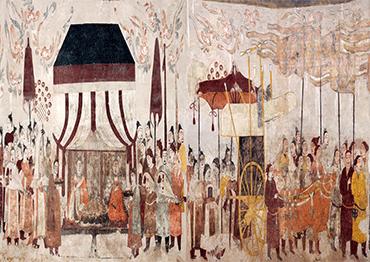Besides upgrading preservation for artifacts and cultural relics, Chinese museums have sought cooperation and communication with overseas museums and archaeological organizations, holding exchange exhibitions and collaborating on research projects and joint archaeological research.
The Palace Museum in Beijing, also known as the Forbidden City, has built a platform for international cooperation to promote archaeology, cultural preservation and exhibitions to go global. In September 2023, an exhibition titled “Thriving for a Collaborative World: ‘Belt and Road’ Cooperation in Cultural Heritage and Archaeology” was held at the Palace Museum. The exhibition highlighted achievements in 44 collaborative archaeological projects in the last decade, involving 24 countries including China, Russia, Italy, Britain, the US, Kazakhstan, Uzbekistan, Mongolia and the United Arab Emirates.
Archaeologists from Chinese museums and research institutions have assisted in a restoration of Angkor Ta Keo Temple in Cambodia, the preservation of historical and cultural relics in Khwarazm, Uzbekistan, and the restoration of the nine-story temple complex in Durbar Square, Kathmandu, Nepal after the devastating earthquake of 2015, as well as an eight-year excavation at the two port sites of Pattanam and Kollam (Quilon) in Kerala, southern India.
Xu Haifeng, director of the Institute of Archaeology of the Palace Museum, told weekly news magazine Outlook in September 2023 that Chinese archaeologists lived and ate together with local archaeologists in these countries while they investigated and excavated ancient remains. “We adopted and promoted the concepts, methods and means of Chinese archaeologists through profound cooperation with our counterparts in those nations,” Xu said.
The Palace Museum, according to Xu, has brought advanced scientific and archaeological equipment and sent technicians to local archaeological sites, as well as prepared information.
Referring to the collaboration with Indian archaeologists, Xu said they would send data back to the Palace Museum after collecting samples to compare with domestic databases.
“We could quickly analyze the age, origin, kiln, process and technology where the samples were collected, which impressed our Indian counterparts,” Xu said.
The same archaeological concepts and methods were applied to a project with the UAE in 2019. After the first joint excavation, the UAE decided to hand over excavation and research at another two archaeological sites, the ancient town of al-Nudud and al-Mataf in the Julfar protection area, to the Palace Museum.
Wang Xudong, current director of the Palace Museum, said the Palace Museum would continue pushing for its archaeological efforts to go global, and engage in more cooperative projects with other countries to promote exchanges and communication among civilizations.
Other than joining in international archaeological research, leading museums in China are involved in providing help with expertise and offering safe havens for endangered cultural properties from other countries.
Opening in early June, in partnership with the International Alliance for the Protection of Heritage in Conflict Areas (ALIPH), the National Museum of China in Beijing has held an exhibition titled “Salvaged from the shadows, protecting cultural heritage,” featuring ALIPH’s work around the world.
Established in 2017 in Geneva, Switzerland, ALIPH is an international organization dedicated to the protection of cultural heritage in conflict areas. Through international cooperation, ALIPH has supported about 450 projects in at least 35 countries.
China was one of the founding members of ALIPH in 2017. National Museum Director Gao Zheng told NewsChina the museum serves as one of the world’s three international safe havens that afford shelter to heritage in danger, with the other two being the Musée du Louvre Lens in France and the Swiss National Museum. The launch of ALIPH, according to Executive Director of ALIPH Valery Freland, allows partners to work together for the rehabilitation of artifacts which were damaged by war.
The National Museum, along with other Chinese archaeologists, has provided professional advice on heritage protection. Furthermore, the alliance has funded a lot of work to collect 3D digital imaging and data on important world heritage sites. Freland told the Global Times that ALIPH has a strong partnership with China. He expressed his hope to have more Chinese expertise within ALIPH and his eagerness to work with the Alliance for Cultural Heritage in Asia, an organization founded by China.
“During recent years, the National Museum has focused on deepening civilization exchange, communication and mutual learning, gradually establishing an international partnership network, and has effectively expanded the content and space for international cooperation,” wrote Zhu Xiaoyun, director of international cooperation at the National Museum in an article for Outlook magazine in February 2024.

 Old Version
Old Version



